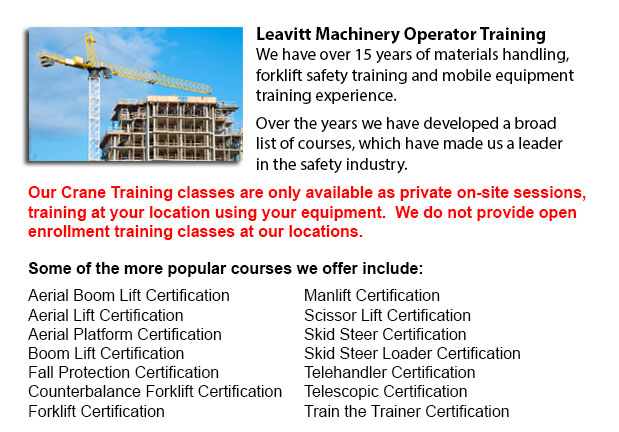
Overhead Crane Operator Training Scottsdale - Our overhead crane operator training course is intended to teach workers the basics of overhead crane/sling operation and pre-shift checks. Programs are taught by our professional trainers and consultants. Well-trained workers are more efficient and productive, that saves on costs associated with property damage, merchandise damage, and accidents because of the utilization of incorrect operating procedures. Our overhead crane certification is customized for workers who have literacy barriers, reducing certification time by 50 percent.
The overhead crane has been built to be used doing repetitive lifting activities. This particular type of crane can be used in various capacities. They may be used for specialized hoisting jobs like installing or removing major plant equipment.
Operators and worker should employ safe rigging practices in order to safely operate an overhead crane. This will require both knowledge and practice because the load must be properly rigged to guarantee its stability when hoisted. Before starting a lifting job, it should be determined that the crane is right for the job, with appropriate travel, lift and capacity. The crane must be subjected to a thorough visual and physical check before use. The capacity of all machinery, including the hardware, rope and slings, must never exceed load weight capacities.
The rigger has to know the correct sling for every lift and check slings and other rigging hardware before using. Clear signals have to be used in communications with the crane operator. A signaler has to be designated for the role and signals should be agreed upon. The crane operator should follow instructions from the designated individual only. If a wired or remote controller is being used, the operator should be trained in all its functions.
To be able to guarantee the safety of personnel, a warning must be issued and the path of the load should be cleared of all obstructions before the lift begins. Individuals must not be allowed to walk under the lift loads. The crane hoist must be centered over the load before hoisting in order to prevent swinging. The safety catch has to be closed immediately after sliding the sling entirely onto the lifting hook. Sling legs that are not used must be secured so they do not drag. Never leave loose materials on a load being lifted. Watch that hands and fingers are clear when slack is taken out of a sling. Step clear of the danger zone before the lift is carried out.
-
Crane Certification Scottsdale
Crane Certification Scottsdale - The Crane Certification Program consists of the industry suggested subject matter that would teach the efficient and safe operation of cranes. The person would train in the following: pre-operational, operational and... More -
Heavy Equipment Operator Training Scottsdale
Heavy Equipment Operator Training Scottsdale - Heavy equipment operator training facilities that provide good standards within the business, offering field performance tasks and additional equipment training are really sought after training features.... More -
Heavy Equipment Training School Scottsdale
Heavy Equipment Training School Scottsdale - HEO or the heavy equipment operator courses would provide you with the skills and knowledge required so as to enter the workforce as an entry level heavy equipment operator. In this twelve week course plus... More -
Crane Operator Classes Scottsdale
Crane Operator Classes Scottsdale - For the operators and the supervisors, current and new, the crane operator training course is suitable for all. Course content deals with applicable federal, provincial and state safety regulations. The training's... More -
Forklift Operator Certification Scottsdale
Forklift Operator Certification Scottsdale - Certification for forklifts are required to guarantee the safe operation of forklifts for those employers in warehouse, construction and industrial environments. The training needs to involve a method of e... More -
Crane Training Schools Scottsdale
Crane Training Schools Scottsdale - Our different programs for Mobile Crane Operation are meant for skilled operators who needs certification or re-certification, and for inexperienced people who are searching for their very first job as an operator... More -
Aerial Boom Lift Training Scottsdale
Aerial Boom Lift Training Scottsdale - Aerial Boom Lift Training is necessary for any individual who supervises, operates or works near boom lifts. This particular type of aerial lift or aerial work platform is utilized for lifting individuals, mater... More -
Telehandler Training Scottsdale
Telehandler Training Scottsdale - Telescopic handlers often known as telehandlers for short, are an extremely popular piece of heavy construction equipment. They are widely used in the construction and agricultural industries. These equipments have f... More

Forklift Training Scottsdale
TOLL FREE: 1-888-254-6157
Scottsdale, Arizona
forkliftcertificationscottsdale.com
Email Us
About Us


